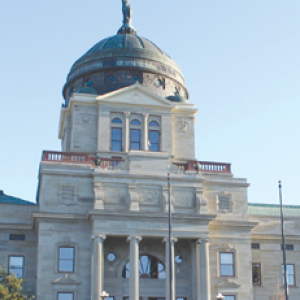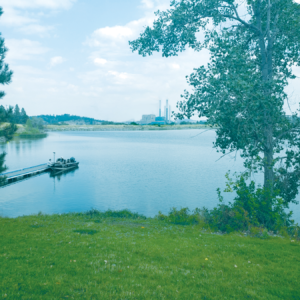By Evelyn Pyburn
Montana’s economy is not doing too badly, and Yellowstone County’s economy “grew like crazy” over the past few months, according to economist Pat Barkey, Director of the Bureau of Business and Economic Research (BBER), University of Montana. He called the economy for Billings “a Goldilocks recovery,” following several years of lackluster performance because of a decline in mining, which happens to be the most important industry to the county because of the number of mines headquartered in Billings.
Barkey gave a mid-year update on what’s been happening economically in the state, early this month, at the Northern Hotel in Billings, with a special emphasis on the plight of housing.
The housing market is frozen. The country had a long period of low interest rates followed by high rates, which has prompted people who already own their home to resist selling because they don’t want to assume high interest rates, which is “freezing markets.”
Otherwise a little noted news story, he said, is how well the US economy is doing. The economy has accelerated – growing at 2.8 percent as compared to last summer’s 2 percent. We are leaving our “peers” behind, said Barkey, referring to Canada and European countries. He noted that the US share of the global economy is 26.5 percent – “higher than ever.”
He noted that India, China and Russia are growing at a faster rate, but in response to a question, he explained that he didn’t include them as “peer” countries, because their economies are not mature economies and are not as large. (China’s economy is 65 percent that of the US.)
It is no surprise that the cost of housing in Montana has skyrocketed over the past few years. The median cost of a home in Yellowstone County is currently about $419,000. In Gallatin County it’s $857,000 – about 120 percent more than in 2014.
A more meaningful stat is the ratio of the cost of housing to average income. In Gallatin County, which has the highest median income per household in the state, the ratio is 10.3. Yellowstone County has one of the better ratios at 5.5. Lewistown, however, has a ratio of 3.6.
The increase in the cost of housing has broader impacts, Barkey pointed out. It increases sprawl as people move out seeking lower priced housing. It limits economic growth as mobility is reduced prohibiting people from seeking better jobs. And, those families have less to spend in all other aspects of life from food to recreation.
It generates a “war” between generations – one that “tragically the Boomers are winning – we have shut 20 and 30 year olds out of buying a house, which stops their wealth growth.” The level of home ownership for the younger generation compared to the “boomers” at the same age, is 40 percent less.
The cost of housing also impacts the rate of homelessness, which has been rising in most Montana communities.
Barkey noted that there is always a flip side to every economic stat. “High prices are great for sellers.”
The solution for Montana communities is to build “houses, houses, houses.” “We are not building enough houses,” said Barkey, while showing graphs which demonstrated that in the past most Montana cities were building houses faster than their population was growing, especially so in the 1980s. That has totally flip-flopped; often to a dramatic degree for some cities.
Billings had its own period when population exceeded housing supply – during the oil boom – but the oil bust changed that. Billings had a surplus of housing before COVID, but the aftermath of COVID “wiped it out” — it is currently neutral.
Barkey noted that in the past federal policies and regulations have focused on increasing demand for housing, while local regulations focused more on increasing supply. Some of Barkey’s recommendations included:
—don’t add more policies. There tends to be a “disconnect between intentions and outcomes.”
—don’t add more to demand.
—consider ending policies that don’t accomplish their stated objectives.
—consider ending the mortgage tax deduction, since it did not do what was intended.
—start holding local governments accountable for achieving progress. One measure for that would be to “assess what percent of vacant land that is buildable is vacant.”
Besides dealing with the impacts of a frozen housing market, the country is experiencing a slowdown in manufacturing, but a big surprise is that generally the economy has accelerated – growing at 2.8 percent as compared to last summer’s 2 percent.
The forecast for Montana’s economy is not at a point of “high drama,” said Barkey, but “we continue to be surprised as it remains on “the upside.”
Little discussed is the fact that the US economy has accelerated, reported Barkey. The US economy is dominated by what the federal reserve is doing.
The bad news is that while the rate of Inflation is fading, “high prices are not fading and they are here to stay.”
Some of the reason for the US growth is the expenditure by government of money that doesn’t exist. “We are eating a lot of sugar candy,” said Barkey, “and it is not sustainable….We are doing it more than other countries that are our peers.”
Interest payments on the national debt exceed what the US spends on defense.
In Montana ag prices “are pretty good.”
“The wood products industry is changing and it is tough…those prices are low.”
Metals and mining is a “mixed bag.”
Montana industries are impacted by inflation. While inflation was 9 percent and it has dropped to 3.1 percent, “it is not falling anymore.” The Feds target is 2 percent, reminded Barkey, noting that contributing the most to costs are transportation and housing.
Energy prices have “plateaued” but they have done so at high prices.
The bad news, emphasized Barkey, is that prices are not going to go down.
The “appetite” for labor is shrinking. Job postings are declining. “We are not seeing as many voluntary quits.”
Montana added 10,000 jobs last year, but that is less than the previous year, said Barkey, “The trajectory is smoothing out.”
Construction is starting to cool off, while health care is “coming back” and the accommodations industry is strong.
Workers’ wages in Montana increased $200 million last year, which has a lot to do with the tech, service and health care market segments.
Largely because of the health care industry recovery, “Billings is back on track.”
Counties of the major cities in Montana are all growing economically, except for Cascade which showed negative growth due to construction that happened last year which is not being repeated this year. Of the counties, Gallatin is growing the most followed by Yellowstone, Missoula and Flathead.
Looking at tax revenues for the state (the first report for which for this year just recently came out) indicate that the State of Montana tax revenues are not going to be as high as in the past couple of years. They look to remain flat. “Complete stagnation,” said Barkey, “Revenue growth is over.”






